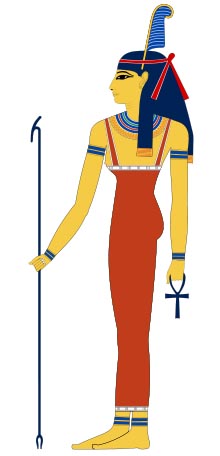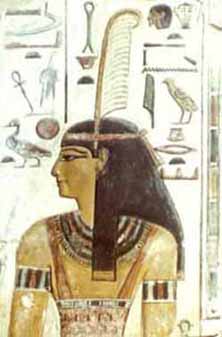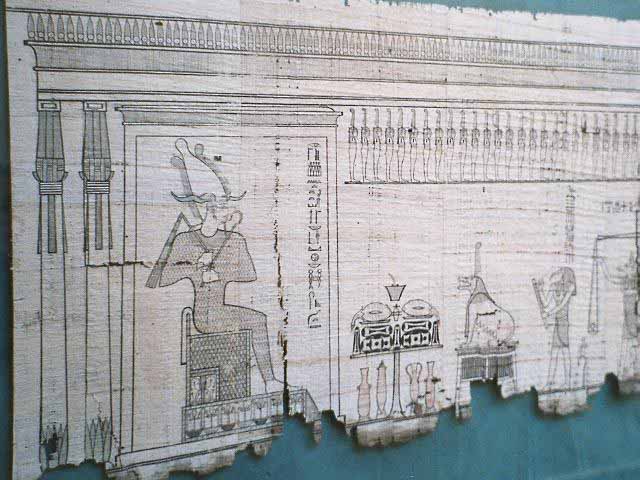

Maat wearing feather of truth



Maat wearing feather of truth

Maat is depicted as a tall woman wearing a crown surmounted by a huge ostrich feather. Her totem symbol is a stone platform or foundation, representing the stable base on which order is built.
Maat or Mayet, thought to have been pronounced as was the Ancient Egyptian concept of truth, balance, order, law, morality, and justice who is sometimes personified as a goddess regulating the stars, seasons, and the actions of both mortals and the deities, who set the order of the universe from chaos at the moment of creation. Later, as a goddess in other traditions of the Egyptian pantheon, where most goddesses were paired with a male aspect, her masculine counterpart was Thoth and their attributes are the same.
Like Thoth, she was seen to represent the Logos of Plato. After the rise of Ra they were depicted as guiding his Solar Barque, one on either side.
After her role in creation and continuously preventing the universe from returning to chaos, her primary role in Egyptian mythology dealt with the weighing of souls that took place in the underworld, Duat.
Her feather was the measure that determined whether the souls (considered to reside in the heart) of the departed would reach the paradise of afterlife successfully.
Ma'at as a principle was at least partially codified into a set of laws, and expressed a ubiquitous concept of correct from wrong characterized by concepts of truth and a respect for, and adherence to, this divine order believed to be set forth by her at the time of the world's creation. This divine order was primarily conceived of as being modeled in various environmental, agricultural, and social relationships.
In addition to the importance of the Ma'at, several other principles within Ancient Egyptian law were essential, including an adherence to tradition as opposed to change, the importance of rhetorical skill, and the significance of achieving impartiality, and social equality. Thus, to the Egyptian mind, Ma'at bound all things together in an indestructible unity: the universe, the natural world, the state, and the individual were all seen as parts of the wider order generated by Ma'at!
During the Greek period in Egyptian history, Greek law existed alongside that of the Egyptian law, but usually these laws favored the Greeks. When the Romans took control of Egypt, the Roman legal system which existed throughout the Roman empire was imposed in Egypt.
The underlying concepts of Taoism and Confucianism resemble Ma'at at times. Many of these concepts were codified into laws, and many of the concepts often were discussed by ancient Egyptian philosophers and officials who referred to the spiritual text known as the Book of the Dead.
Later scholars and philosophers also would embody concepts from the wisdom literature, or seboyet. These spiritual texts dealt with common social or professional situations and how each was best to be resolved or addressed in the spirit of Ma'at - it was very practical advice, and highly case-based, so that few specific and general rules could be derived from them.
The goddess Ma'at was the goddess of harmony, order, and truth represented as a young woman, sitting or standing, holding a scepter in one hand and an ankh in the other. Sometimes she is depicted with wings on each arm or as a woman with an ostrich feather on her head.
Because it also was the pharaoh's duty to ensure truth and justice, many of them were referred to as Meri-Ma'at (Beloved of Ma'at). Since she was considered as merely the concept of order and truth, it was thought that she came into existence at the moment of creation, having no creator and made the order of the entire universe from the pandemonium.
When beliefs about Thoth arose in the Egyptian pantheon and started to consume the earlier beliefs at Hermopolis about the Ogdoad, it was said that she was the mother of the Ogdoad and Thoth the father.
In Duat, the Egyptian underworld, the hearts of the dead were said to be weighed against her single Shu feather, symbolically representing the concept of Ma'at, in the Hall of Two Truths. A heart which was unworthy was devoured by the goddess Ammit and its owner condemned to remain in Duat.
The heart was considered the location of the soul by ancient Egyptians. Those people with good, (and pure), hearts were sent on to Aaru. Osiris came to be seen as the guardian of the gates of Aaru after he became part of the Egyptian pantheon and displaced Anubis in the Ogdoad tradition.

Funerary Scene
The weighing of the heart, pictured on papyrus, (in the Book of the Dead, typically, or in tomb scenes, etc.), shows Anubis overseeing the weighing, the lioness Ammit seated awaiting the results so she could consume those who failed. The image would be the vertical heart on one flat surface of the balance scale, and the vertical Shu-feather standing on the other balance scale surface. Other traditions hold that Anubis brought the soul before the posthumous Osiris who performed the weighing.
Ma'at was commonly depicted in ancient Egyptian art as a woman with outstretched wings and a "curved" ostrich feather on her head or, sometimes, just as a feather. These images are on some sarcophagi as a symbol of protection for the souls of the dead. Egyptians believed that without Ma'at there would be only the primal chaos, ending the world. It was seen as the Pharaoh's necessity to apply just law, following Ma'at.
One aspect of ancient Egyptian funerary literature which often is mistaken for a codified ethic of Ma'at is Chapter 125 of the Book of the Dead, often called the 42 Declarations of Purity or the Negative Confession. These declarations varied somewhat from tomb to tomb, and so can not be considered a canonical definition of Ma'at.

Rather, they appear to express each tomb owner's individual conception of Ma'at, as well as working as a magical absolution (misdeeds or mistakes made by the tomb owner in life could be declared as not having been done, and through the power of the written word, wipe that particular misdeed from the afterlife record of the deceased). Many of the lines are similar, however, and they can help to give the student a "flavor" for the sorts of things which Ma'at governed - essentially everything from the most formal to the most mundane aspect of life.
Many versions are given on-line, unfortunately seldom do they note the tomb from which they came or, whether they are a collection from various different tombs. Generally, they are each addressed to a specific deity, described in his or her most fearsome aspect.